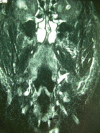An inflammatory pseudotumour of the larynx: a case report and literature review of an unusual tumour
- PMID: 23056150
- PMCID: PMC3464076
- DOI: 10.3332/ecancer.2012.273
An inflammatory pseudotumour of the larynx: a case report and literature review of an unusual tumour
Abstract
Background: Inflammatory pseudotumour (IPT) is a rare benign pseudoneoplastic proliferation of unknown etiology, often showing locally aggressive behaviour. Conflicting theories about exaggerated response to injury versus true neoplastic origin have been suggested.
Methods: We report a case of laryngeal pseudotumour in a 73-year-old man presenting with hoarseness and slowly progressive dyspnea and a short review of the English language literature on the subject.
Results: Management consisted of midline vertical thyrotomy, excision of the tumour, and a temporary tracheotomy. No recurrence observed eight months postoperatively.
Conclusions: Laryngeal IPT is extremely rare, and it may easily be misinterpreted as a malignant tumour. Conservative excision and anti-inflammatory therapy are advocated, since its general behaviour is benign.
Keywords: inflammatory myofibroblastic tumour; inflammatory pseudotumour; laryngeal neoplasms; plasma cell granuloma.
Figures




References
-
- Manni JJ, Mulder JJ, Schaafsma HE, van Haelst UJ. Inflammatory pseudotumor of the subglottis. Eur Arch Otorhinolaryngol. 1992;249(1):16–9. - PubMed
Publication types
LinkOut - more resources
Full Text Sources
